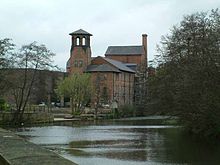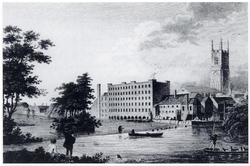Lombe's Mill
Lombe's Mill England was the first successful silk throwing mill in England. It was built in an island on the River Derwent in Derby. It was built after John Lombe visited Piedmont in 1717, and returned to England with details of the Italian silk throwing machines- the filatoio, and the torcitoio., and some Italian craftsmen.[1] The architect was George Sorocold.
Location
Lombe's Mill was built next to Thomas Colchett's 1704 mill on the west bank of the River Derwent in Derby. At this point a weir had been constructed across the river and the mill was built on an island downstream, which separated the river from the tail race of three corn mills. This was also called a fleam or a leat. Derby was a key location, as the river had a fast flow and it was here that it was crossed by the London to Carlisle road
History
This mill is significant as it was the first successful silk throwing mill in England, and probably the first fully mechanised factory in the world.[2] The first mill, that Thomas Cotchett built in Derby in 1704, was a failure, so John Lombe paid a visit in 1716 to the successful silk throwing mill in Piedmont. This was an early example of industrial espionage. He arrived back in Derby with the knowledge and a group of Italians. He and his half brother Thomas Lombe, born 1685, instructed George Sorocold to build a mill to his design and fitted it with the new machines. It was built to the south of Cotchetts Mill. Thomas Lombe was given a 14 year patent to protect the design of the throwing machines he used. The King of Sardinia responded to this challenge badly, and stopped exporting suitable raw silk. It is speculated that he was responsible for John Lombes mysterious death six years later in 1722. His elder brother, Thomas Lombe, born 1685, took over the business. When the patents lapsed in 1732, other mills were built in Stockport and Macclesfield. To the north of the powered Italian Works an unpowered Doubling Shop was built- this happened before 1739. The mill was sold in 1739 to Thomas Wilson, and an inventory taken which still exists today.[1]
The mill- the Italian Works
Little of the original mill remain. It is known from written sources that it was five storeys high rectangular in plan. It was built of brick, in flemish bond, being 33.5m long by 12m wide. It was built on a series of stone arches that allowed the waters of the River Derwent to flow through. The mill was 17m high,topped by a shallow pitched roof.The throwing machines were two storeys high, and pierced the first floor. The winding machines were situated on the top three floors. All the machines were powered by Sorocolds external undershot waterwheel- one that was 7m in diameter and 2m in width. Its axle entered the mill through a navel hole at first floor level. It drove a vertical shaft which was 0.45m square. This drove a horizontal shaft or lay shaft that ran the length of the mill. The torcitoios and filatoios took their power from this shaft. The vertical shaft was extended past the second floor by an iron gudgeon to a further vertical shaft that reached the top 3 floors to drive the winding machines. The mill needed to be heated in order to process the silk and this was explained in the 1718 patent. It was reported in 1732 that Lombe used a fire engine (steam engine) to pump hot air round the mill. The stair column was 19.5m high, its layout is not known and there is no information on how bales were hoisted between the floors.[1]
The mill- the Doubling Shop
The main range was three storeys high, 42.4m by 5.5m. Each floor was used for doubling- and there were 306 doubling machines.[1]
The silk throwing process
Silk is a naturally produced fibre obtained from many species of the silk moth. In 1700 the favoured silk was produced by a moth (Bombyx mori), that used it to spin a closed cocoon to protect her larvae. These fed on the mulberry leaf which was grown in Italy. Silk fibres from the Bombyx mori silkworm have a triangular cross section with rounded corners, 5-10 μm wide. The silk is a protein called fibroin and it was cemented in place by the use of a gum, another protein called sericin. The cocoons were harvested and placed in troughs of hot water that dissolved the gum and allowed the single thread to be wound into a skein. The skeins were placed into bales and taken to the mill for processing. Three sorts of yarn could be produced: no-twist which was suitable for weft, tram that had received a slight twist making it easier to handle, and organizine which had a greater twist and was suitable for use as warp.[3] Reeling is the industrial process where silk that has been wound into skeins, is cleaned, receives a twist and is wound onto bobbins. Silk throwing is the process where the thread from the bobbins is twisted again to form tram and or organizine. The yarn is now twisted together with threads, in a process known as doubling. Colloquially silk throwing can be used to refer to the whole process: reeling, throwing and doubling.[1]
In 1700, the Italians were the most technologically advanced throwsters in Europe and had developed two machines capable of winding the silk onto bobbins whine putting a twist in the thread. They called the throwing machine, a filatoio, and the doubler, a torcitoio. There is an illustration of a circular handpowered throwing machine drawn in 1487 with 32 spindles. It was hand powered. The first evidence of a externally powered filatoio comes from the thirteenth century, and the earliest illustration from around 1500.[1] Filatorios and torcitoios contained parallel circular framss that revolved round each other on a central axis. The speed of the relative rotation determined the twist. Silk would only cooperate in the process if the temperature and humidity were high, in Italy the temperature was elevated by sunlight but in Derby the mill had to be heated, and the heat evenly distributed.[1]
The Silk Mill today

The mill then passed through several hands and has been rebuilt several times, but the modified structure still exists and has been restored to house the Derby Industrial Museum. A Bas relief sculpture may be found of John Lombe at the nearby Exeter Bridge
See also
References
- Notes
- ^ a b c d e f g Callendine 1993
- ^ Darley 2003, p. 103
- ^ Rayner 1903
- Bibliography
- Callandine, Anthony (1993). "Lombe's Mill: An Exercise in reconstruction". Industrial Archaeology Review. XVI (1). Maney Publishing. ISSN 0309-0728.
- Darley, Gillian (2003). Factory (Objekt). London: Reaktion Books. ISBN 1-86189-155-5.
- Rayner, Hollins (1903). Silk throwing and waste silk spinning. Scott, Greenwood, Van Nostrand.


